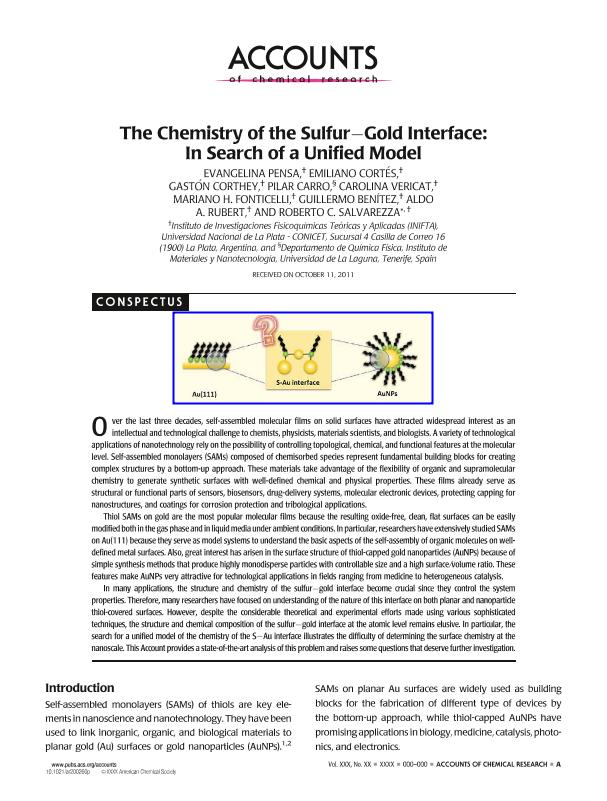Artículo
The Chemistry of the Sulfur-Gold Interface: In Search of a Unified Model
Pensa, Evangelina Laura ; Cortés, Emiliano
; Cortés, Emiliano ; Corthey, Gastón
; Corthey, Gastón ; Carro, Pilar; Vericat, Carolina
; Carro, Pilar; Vericat, Carolina ; Fonticelli, Mariano Hernan
; Fonticelli, Mariano Hernan ; Benitez, Guillermo Alfredo
; Benitez, Guillermo Alfredo ; Rubert, Aldo Alberto
; Rubert, Aldo Alberto ; Salvarezza, Roberto Carlos
; Salvarezza, Roberto Carlos
 ; Cortés, Emiliano
; Cortés, Emiliano ; Corthey, Gastón
; Corthey, Gastón ; Carro, Pilar; Vericat, Carolina
; Carro, Pilar; Vericat, Carolina ; Fonticelli, Mariano Hernan
; Fonticelli, Mariano Hernan ; Benitez, Guillermo Alfredo
; Benitez, Guillermo Alfredo ; Rubert, Aldo Alberto
; Rubert, Aldo Alberto ; Salvarezza, Roberto Carlos
; Salvarezza, Roberto Carlos
Fecha de publicación:
03/2012
Editorial:
American Chemical Society
Revista:
Accounts of Chemical Research
ISSN:
0001-4842
Idioma:
Inglés
Tipo de recurso:
Artículo publicado
Clasificación temática:
Resumen
Over the last three decades, self-assembled molecular films on solid surfaces have attracted widespread interest as an intellectual and technological challenge to chemists, physicists, materials scientists, and biologists. A variety of technological applications of nanotechnology rely on the possibility of controlling topological, chemical, and functional features at the molecular level. Self-assembled monolayers (SAMs) composed of chemisorbed species represent fundamental building blocks for creating complex structures by a bottom-up approach. These materials take advantage of the flexibility of organic and supramolecular chemistry to generate synthetic surfaces with well-defined chemical and physical properties. These films already serve as structural or functional parts of sensors, biosensors, drug-delivery systems, molecular electronic devices, protecting capping for nanostructures, and coatings for corrosion protection and tribological applications. Thiol SAMs on gold are the most popular molecular films because the resulting oxide-free, clean, flat surfaces can be easily modified both in the gas phase and in liquid media under ambient conditions. In particular, researchers have extensively studied SAMs on Au(111) because they serve as model systems to understand the basic aspects of the self-assembly of organic molecules on welldefined metal surfaces. Also, great interest has arisen in the surface structure of thiol-capped gold nanoparticles (AuNPs) because of simple synthesis methods that produce highly monodisperse particles with controllable size and a high surface/volume ratio. These features make AuNPs very attractive for technological applications in fields ranging from medicine to heterogeneous catalysis. In many applications, the structure and chemistry of the sulfurgold interface become crucial since they control the system properties. Therefore, many researchers have focused on understanding of the nature of this interface on both planar and nanoparticle thiol-covered surfaces. However, despite the considerable theoretical and experimental efforts made using various sophisticated techniques, the structure and chemical composition of the sulfurgold interface at the atomic level remains elusive. In particular, the search for a unified model of the chemistry of the SAu interface illustrates the difficulty of determining the surface chemistry at the nanoscale. This Account provides a state-of-the-art analysis of this problem and raises some questions that deserve further investigation.
Palabras clave:
GOLD
,
SULFUR
,
INTERFACE
,
SELF ASSEMBLED MONOLAYERS
Archivos asociados
Licencia
Identificadores
Colecciones
Articulos(INIFTA)
Articulos de INST.DE INV.FISICOQUIMICAS TEORICAS Y APLIC.
Articulos de INST.DE INV.FISICOQUIMICAS TEORICAS Y APLIC.
Articulos(OCA CIUDAD UNIVERSITARIA)
Articulos de OFICINA DE COORDINACION ADMINISTRATIVA CIUDAD UNIVERSITARIA
Articulos de OFICINA DE COORDINACION ADMINISTRATIVA CIUDAD UNIVERSITARIA
Citación
Pensa, Evangelina Laura; Cortés, Emiliano; Corthey, Gastón; Carro, Pilar; Vericat, Carolina; et al.; The Chemistry of the Sulfur-Gold Interface: In Search of a Unified Model; American Chemical Society; Accounts of Chemical Research; 45; 3-2012; 1183-1192
Compartir
Altmétricas



